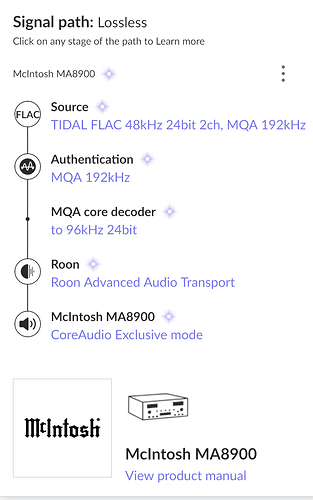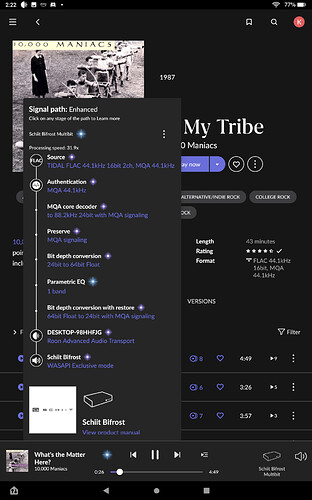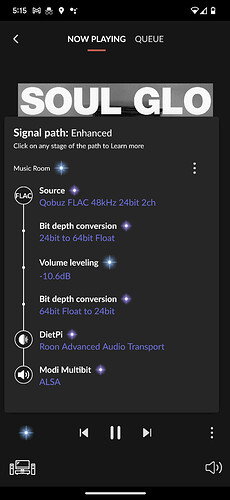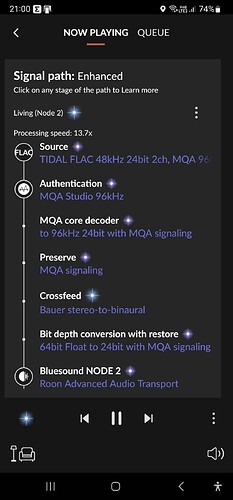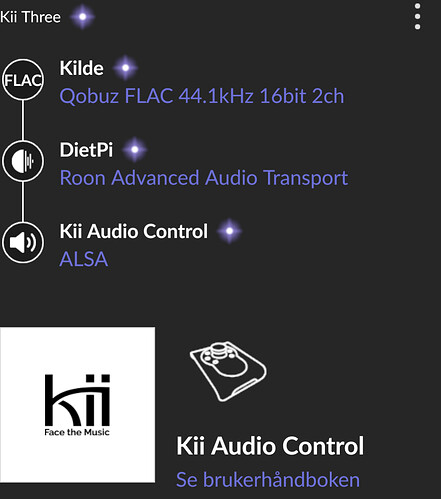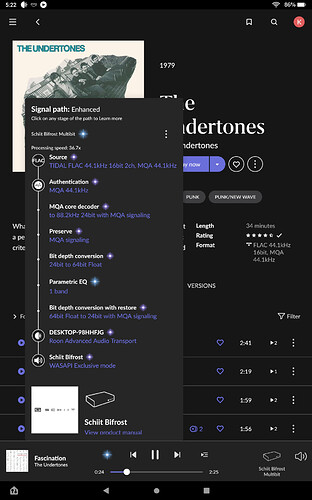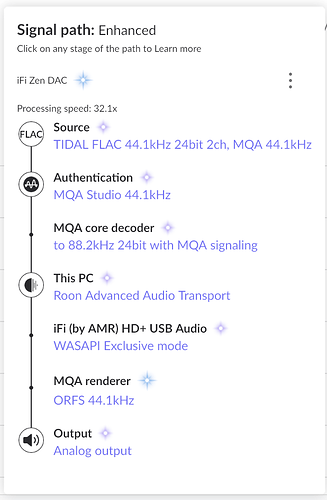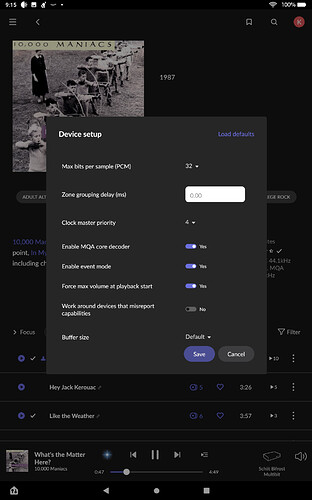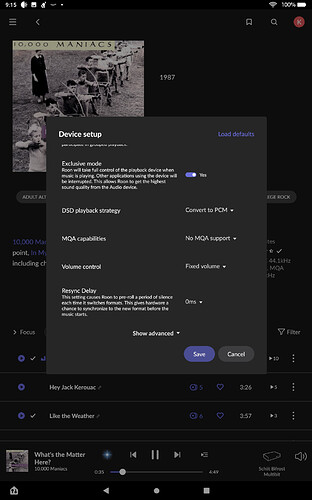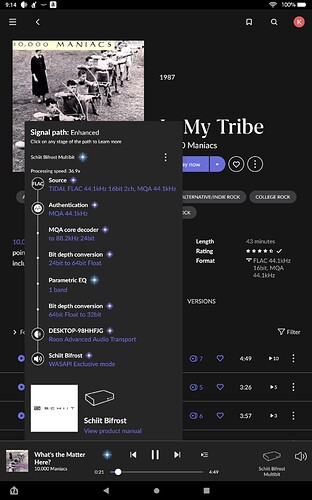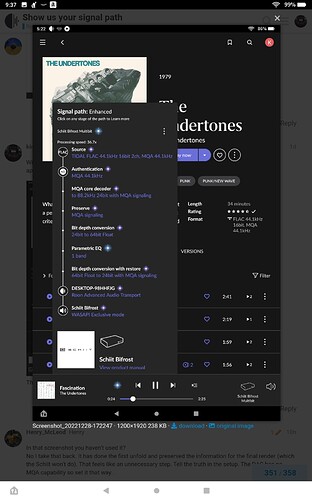Oh wait a minute…the Bifrost makes an audible “click” whenever the digital signal coming into it changes. So that tells me something. I think
I’m highly skeptical of statements like this (quoted from Schiit’s website):
We use True Multibit to denote DACs that have 16-20 actual bits, rather than multilevel noise-shaping delta-sigma DACs, coupled with our unique combination of time- and frequency-domain optimized digital filter, based on math first proposed by Western Electric in 1917, and developed into usable algorithms by a team that included a professor emeritus of math and a Rand Corp mathematician. It’s unlike any other digital filter today, and we believe it provides the closest thing to a true interpolation, while retaining the original samples as closely as possible.
One the one hand, this is not about “interpolation”, it’s about up-sampling, and there is only one theoretically accurate up-sampling, prescribed by the sampling theorem. The more you stray from it, the more artifacts you introduce. Whether or not you actually like how those artifacts sound is irrelevant in my view.
On the other hand, since this is up-sampling and not interpolation, preserving original samples is not a goal of the up-sampling filter. As a matter of fact, some samples ought not be preserved. For example, a signal that consists of alternating +1 and -1 samples is right on the Nyquist frequency and thus is already aliased. Such samples should simply be filtered out, i.e. attenuated as much as possible. If they’re not, the DAC will have to resolve the aliasing ambiguity one way or another, which could result in a bad analog waveform. Audacity DAW does a good job here: if you generate a 22kHz tone at 44.1kHz sampling rate and then up-sample to 88.2kHz, you’ll get silence. If you do the same with a 20kHz tone, it will be preserved faithfully.
Bottom line: if you want DSP, use DSP, no matter what DAC you’re using.
Sorry for the dissertation. Feel free to fork if off topic.
Rollin’ with MQA but not fully decoded. This DAC don’t do that.
I find the light to be a comfort on this cold day.
Hello Doug,
I have the same situation. I think you may need to change the McIntosh settings to MQA decoder and renderer even though it doesnt do that. I had to do that with my Bifrost to get the first decode of MQA . see screenshot. Roon tells you if you are preserving the MQA decode
Thank you for the dissertation
@kim_hixson we don’t have a consensus on best practices for upsampling and Schiit Multibit DACs. Schiit would tell you to do wherever you think sounds best. With my Modi Multibit, I do volume leveling, but I don’t resample up to a higher sample rate. I should say that I’m new to Roon, so I’m not an upsampling expert. That’s why I started off asking you questions.
Ok Jonathan! I certainly do not know much about this stuff, but i just today turned off my DSP and am letting the unprocessed signal go thru the Bifrost. Listening to music that has been ingrained into my head thru hundreds of listenings, i do think there is an improvement in the sound. I cannot pinpoint a particular area but still it seems “better”.
I hear a distinct " click" from the Bifrost when it senses a different bitrate being fed into it, so i do not think it is just sending the signal on to the AVR. Looking forward to lots of listening!
I 100 percent guarantee that the Bifrost is converting the digital signal to analog and sending that to your AVR. It’s literally the only thing it can do. Schiit DACs do not have a “digital passthrough” capability like some streamer DACs do. They only output analog.
Yes i should have known that! Sometimes things analog and digital flummox me. I will say after a few hours of listening the Bifrost seems less analytical and “warmer” than the Sabre ES9026 PRO but with great detail included. Hope you and yours have a wonderful Christmas.
With Roon offering the first decode of MQA I’m going to use it (the “getting my moneys’ worth” approach). DISCLAIMER:
This is in no way claiming that MQA offers any audible sonic benefits
In that screenshot you haven’t used it?
No I take that back. It has done the first unfold and preserved the information for the final render (which the Schiit won’t do). That feels like an unnecessary step. Tell the truth in the setup. The DAC has no MQA capability so set it that way.
Well, I originally DID have it set to not do any MQA decoding (the Bifrost). But the signal path indicated that the MQA signal was being left out and not being given the first decoding step by Roon. However when I set the Bifrost to be a “decoder and renderer”, the signal path showed that the MQA part of the signal was being preserved.
Set the Dac to no MQA and then under advanced set mqa decoder to on. This will make roon do the first unfold.
Last Pic. Third step mqa decoder to 88.2. Is the mqa decode by roon.
Thank you Daniel. However, in this pic the signal path is different and seems to show the MQA signal has been “preserved”. Is that information just for folks who have the MQA rendering capability?
EDIT: i looked at the detailed explanation of the signal path and it answered my question. Roon preserves the MQA signal in order to pass it on to a MQA renderer. I will not give wrong info any more
Yep, only matters if you have an mqa dac and does nothing for your use case except potentally waste processing.
